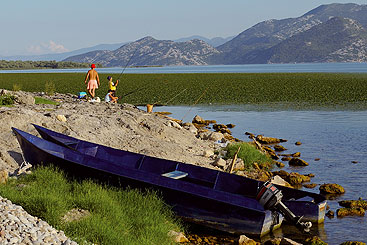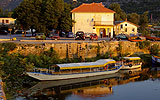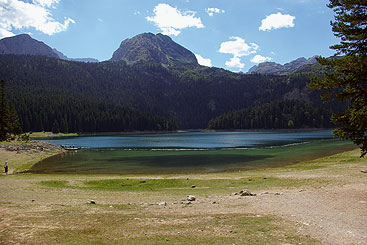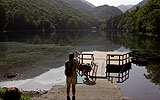The entire Danube River Basin working together as one
ICPDR Danube Watch: Danube Day 2006: River of Life

The entire Danube
River Basin working
together as one
The ICPDR is very pleased to have Montenegro as its newest member. Montenegro declared independence on June 3 2006. A little over two years later, the small and beautiful country has completed signing and ratifying the Danube River Protection Convention.

Montenegro has vast natural resources which include the famous coastline, mountains, canyons and rivers. To preserve its precious natural heritage, Montenegro places high value on the sustainable development, protection of environment and preservation of natural resources.
On the October 28, the ICPDR received the formal letter from Montenegro announcing their ratification of the Danube River Protection Convention, and with this letter the waters of the entire Danube River Basin are united under the Convention.
Before the separation of Serbia and Montenegro
in 2006, the waters of Montenegro’s territory
were included in ICPDR activities. And now,
Montenegro’s ratification of the Danube River Protection
Convention means that all the countries in
the region are now formally acting together under
this framework.
“Since having regained independence, Montenegro has
succeeded to major international and regional organizations
dealing with environmental protection, and to
all the relevant International Conventions”, says Vesko
Garčević, Ambassador of the Mission of Montenegro
to the OSCE and other international organisations.
“Montenegro is proud to join the Danube River Protection
Convention and thus continue to contribute to
the protection of the Danube river basin as a member
party of the ICPDR, to the benefit of all the countries
that form the part of it.”
The ICPDR’s newest member gives the entire region
reason to celebrate. “It’s essential if we are to properly
do our business, that all the countries with territory
in the basin are part of the convention,” says ICPDR
Executive Secretary Philip Weller.
“It is clear that in order to protect rivers and tackle these challenges, countries must work together, since rivers do not observe political boundaries. Overcoming the existing water management challenges can be possible if countries join their efforts. The ICPDR is a good forum to preserve the valuable Danube River basin, and to engage in constructive regional cooperation to meet mutual demands,” says Vesko Garčević, Ambassador of the Mission of Montenegro to the OSCE and other international organisations.

Natural treasures to protect. Montenegro, which means ‘Black Mountain’, has a coast on the Adriatic Sea to the south and borders Croatia to the west, Bosnia and Herzegovina to the northwest, Serbia and the disputed territory of Kosovo to the north and east, and Albania to the south. The country has a total land area of 13,812 sq km while water covers 1.5% or 214 sq km. In July 2008, its population was just over 678,000 inhabitants. Landscapes are rich and varied including high peaks along its borders with Serbia and Albania, a segment of the Karst of the western Balkan Peninsula, and a narrow coastal plain that ranges from 1 to 6 km wide. The mountains of Montenegro include some of the most rugged terrain in Europe.
“By its constitution, Montenegro is an ecological state. As a country with numerous crystal clear rivers and a place where you can visit the second deepest gorge in the world and the deepest one in Europe – the Tara Canyon – Montenegro places high value on sustainable development, protection of the environment and preservation of natural resources”, says Garčević.
There are four National Parks in the country: Durmitor (390 km²) with its glacier lakes, Lovćen (64 km²), Biogradska Gora (54 km²) and Skadar Lake (400 km²). Its UNESCO World Heritage Sites include Durmitor Park and the Tara River Canyon.
Famous for its diversity of flora and fauna, Skadar Lake, Montenegro’s largest National Park, hosts some 270 kinds of birds. Around 90% of the birds are migratory and are of international importance. During the migration season, white little egret, white spoonbill and various kinds of ducks pass over this region. Cormorants nesting in its northern swamps represent one of the three most important cormorant colonies in the world. Rare and endangered curly pelican nests can be found on floating peat islands at the lake’s north end. There are also 50 species of fish, three species of snake and over 30 rare plants gracing the park.

The newest member of the ICPDR family, Montenegro boasts rich and varied landscapes including high peaks along its borders with Serbia and Albania, a segment of Karst of the western Balkan Peninsula, and a narrow coastal plain that ranges from one to six km wide. The mountains of Montenegro include some of the most rugged terrain in Europe.
Challenges and opportunities. Montenegro is wellsuited for tourism development, given its picturesque coast and mountainous northern region. The Government of Montenegro has set the development of the country as an elite tourist destination as a top priority – it is a national strategy to make tourism a major, if not single largest, contributor to the Montenegrin economy. The tourism industry began to recover in the 2000s, and the country has since experienced high growth in the number of tourist visits and overnight stays. However, some of the problems that currently hamper development are inadequate infrastructure, notably the road infrastructure in the north, and electricity and water supply in the south of the country.

“Like many other countries, Montenegro also faces challenges in water management. Clean water production for future generations, management of hydropower, protection of wildlife and habitats - are some of the challenges to be addressed in the coming years”, says Garčević.
“The main problem they face is simply that they’re a relatively small country without a very big administration, so they need support in managing the waters”, says Weller.
“Participation in the ICPDR will be beneficial for Montenegro in many ways,” says Garčević. “Apart from benefiting from the mutual expertise, experience and cooperation, it will help Montenegro in implementing the EU Water Framework Directive which represents the principal tool for water management in Europe. As a country which aspires to join the EU, it is of great importance to use the assistance in this regard, and share the best practices with other countries.”





